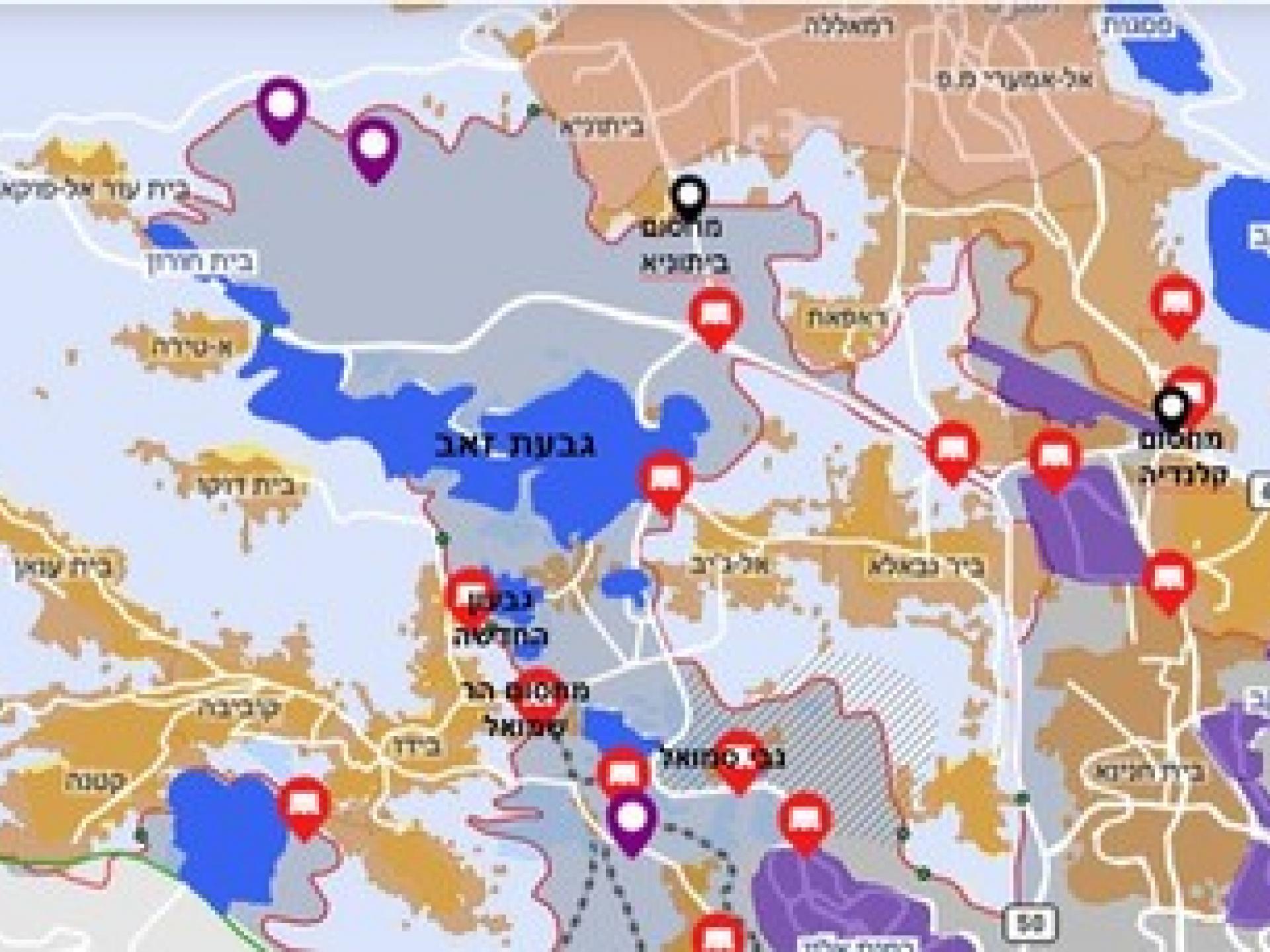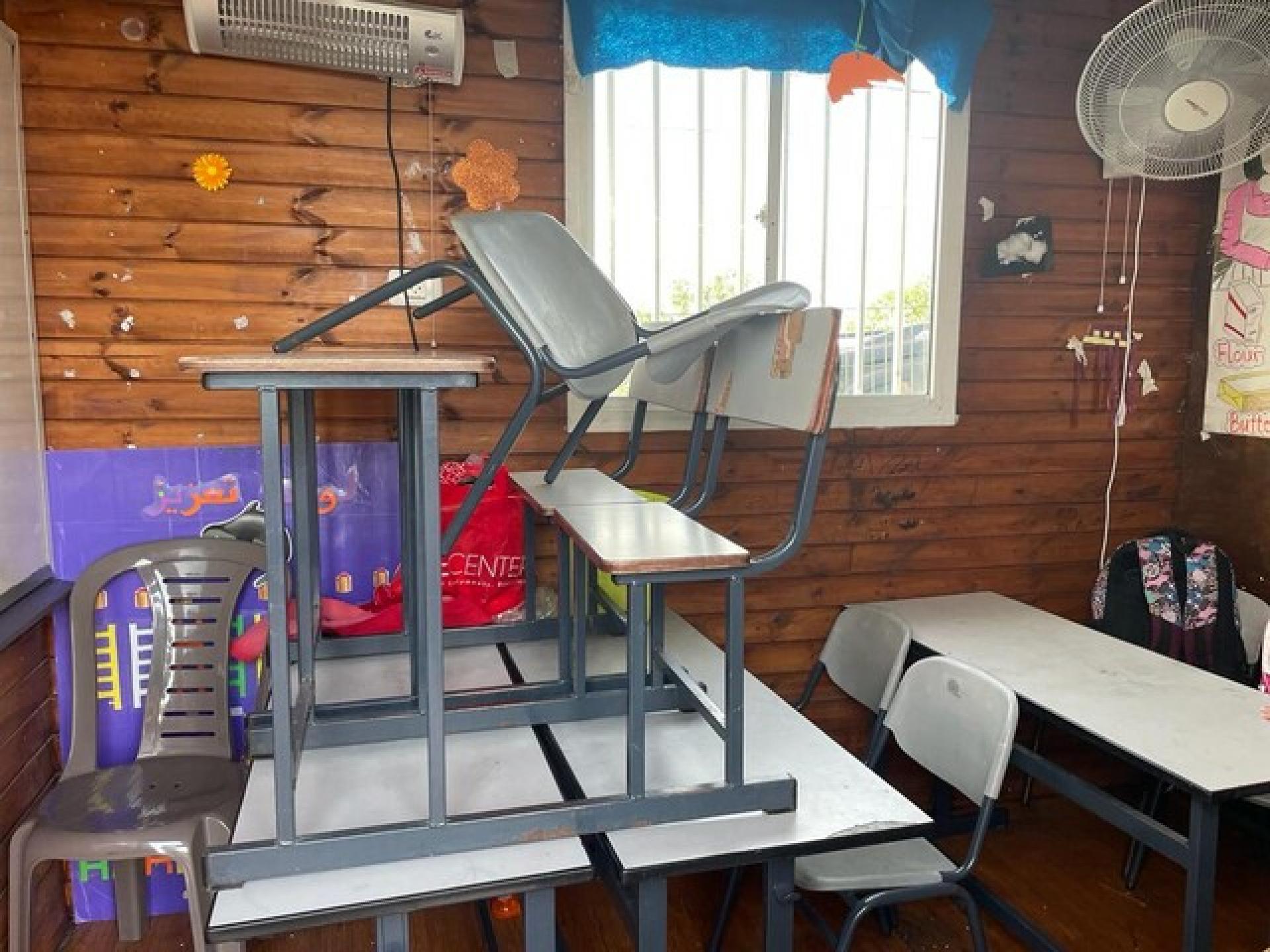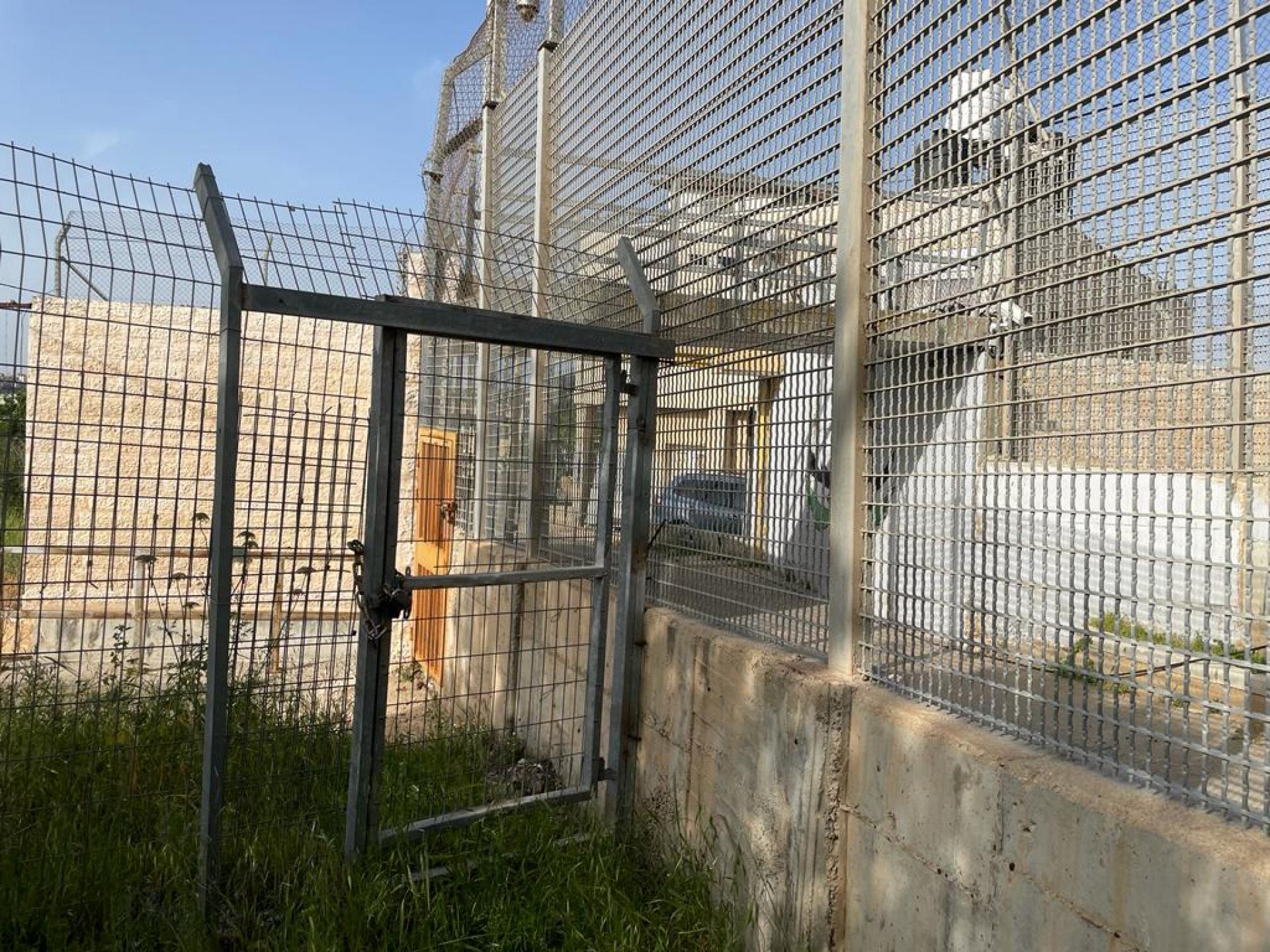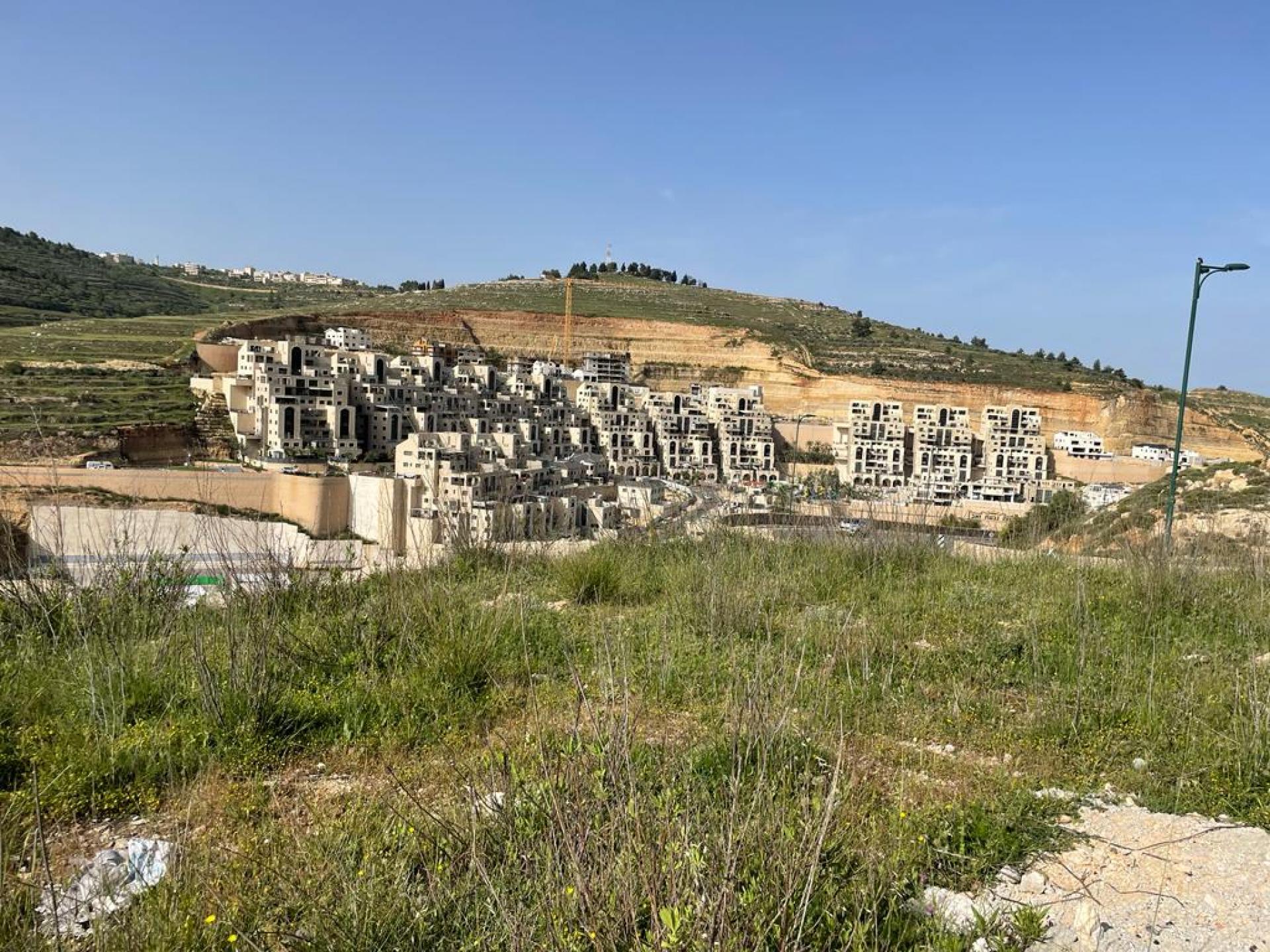North Jerusalem checkpoints
We haven’t driven around the North Jerusalem checkpoints for a long time. We began with Nabi Samauil, the village caught in a Palestinian enclave whose residents hold no transit permits into Jerusalem; We drove along the fence separating Enclave 7 and the neighboring villages; We entered the huge colony of Giv’at Ze’ev that has been spawning one neighborhood after another, all daughter-colonies. It is just about to be connected to the Bet Horon colony on the other side of road 443, creating a buffer between Bituniya and the southern part of Ramllah, and the northern part of Jerusalem. And there’s still more to come.
The PA’s elementary school at Nabi Samauil – One day before the end of the Ramadan month of fasting. The children (kindergarten to 6th grade) arrive slowly from the village itself and from Khalat Al Laila, a village near Giv’at Ze’ev. They look happy to be at school and spontaneously stand in line for their morning roll call that begins at 8 a.m. The teachers wait in the teachers’ room. We are welcomed warmly and are asked to keep coming from time to time. There is a new teacher from a small Bedouin community near the village, who comes on foot. Some teachers arrive from Jerusalem, holding a blue (Israeli) ID, others arrive from the Bir Naballah enclave, holding a special permit, and the teacher from nearby Beit Iksa has yet to arrivew. She is forced to come by car to Qalandiya Checkpoint, and from there back to Nabi Samauil. We photograph a tiny class of 4th graders. All the buildings are actually old asbestos structures, in the winter the roof leaks. There have been problems passing renovation materials and heating stoves at the Jab’a Checkpoint.
We asked about the teachers’ strike in the PA which has been ongoing for a month and a half now. The principal says his entire salary amounts to 4,000 NIS a month, and the PA has cut it to 80% because there is no budget. But not everyone is on strike – some don’t.
The breached fence near Mount Samuel – the Separation Barrier has not yet been erected in this region, and the existing fence is meant to block farmlands previously owned by villagers of Nabi Samauil and other villages near it inside the enclave. At present the owners are not allowed to tend them. It is not unlikely that these areas will eventually serve to expand the colony of Mount Samuel.
The breached fence enables pedestrians holding transit permits to cross from the Bidu Enclave to work in Jerusalem without having to drive to Qalandiya Checkpoint (especially those working on the Road 1 tunnels). This time there are cars parked near the crossing. According to Palestinians crossing there, the more internal checkpoint of the Separation Barrier is not always closed. Netanya asks them what will happen if it closed after they come back from work in their vehicle? They take the chance.
We meet two women holding a blue ID. They work in Jerusalem and live in the Palestinian enclave since having married enclave residents. One of them is newly married from Silwan, working at the Alarov Mall in Jerusalem. She intends to apply for family unification. In the meantime, she lives with her husband’s family. The other woman works as a cleaner in the Mount Samuel colony. Her husband is not interested in requesting family unification.
The Bidu Checkpoint – Men disembark from the “Jerusalem Guard” vehicle, open the checkpoint which is always closed, and cross over heavy equipment for maintenance of the Separation Barrier. The security guards of the “Jerusalem Guard” are Haredi (Ultraorthodox) Jews. We asked one of them if he was trained by the army and his answer was a hesitant “yes”. Under the checkpoint is the “life fabric” road that connects the Bidu and the Bir Naballah enclaves. All enclave areas here are defined as Area C – anachronistic traces of the Oslo Accords. But the built villages are defined as Area B. The PA is in charge of civil life, and Israel is in charge of security. Incidentally, when we asked soldiers in the area’s checkpoints, they were certain that all of these areas were dangerous A Areas.
The New Giv’on – We drove to see the house caged in on all sides, that in fact belongs to the Palestinian village Bet Ij’zah. Their personal checkpoint leading to Bet Ij’zah was open. At the time, Michaela R. and Neta A. were in touch with the owners. We only peeked outside beyond all the numerous fences and gates , and did not meet them.
, and did not meet them.
We entered Giv’at Ze’ev Colony from the nearby Bedouin community – Khalat Al Laila, and wound our way inside the huge colony that continues to grow at a fast pace (in February 2023, the construction of 485 new residences was made legal). We descended to the ravine on the slopes of which new houses are being built, and climbed again, connecting to road 443 that leads to Jerusalem through The Deer Basin – the first distant lasso neighborhood built as is wont by the colonists. Very close, on the other side of road 443, is the colony of Bet Horon. Thus, the direct route of Palestinian villages north of Jerusalem is blocked when wishing to reach the city of Ramallah.
We crossed the Bituniya goods Checkpoint, through which all goods pass from the Ramallah area to Jerusalem. The normal timetable (Sunday through Thursday from 7:30 a.m. to 4:30 p.m., Friday and Jewish holiday eve until 12 noon) has been reduced respectively to the Ramadan month (closed on Fridays) as well as the Jewish holidays. This means there were fewer passage days this April.
Finally, we turned off road 443 towards Atarot and there excitedly met the westward exit of the ‘sunken road’ for Israelis only, being dug underneath the army base near the Qalandiya Checkpoint. Both directions are used there – opposite A-Ram in the east and in the west on road 45 that connects to 443. When the diggers meet, Israelis will be able to bypass the Qalandiya Checkpoint (and give up using the Hizma Checkpoint). Eventually a contiguous route will be driven from the north West Bank colonies through the Kochav Yaacov colony. Everything has already been approved. The Minister of Traffic has seen to this energetically.
We were excited to meet a Palestinian-Jerusalem woman-structural-engineer working on planning a vehicle bridge in the sunken road area. In spite of her explanations, we had a hard time understanding to and from where this bridge would lead. Everything is so complicated… Soon we shall probably see the Qalandiya interchanges, and get it. In the meantime, the landscape is dominated by the powerful pedestrian bridge of the checkpoint, seen from miles around.






